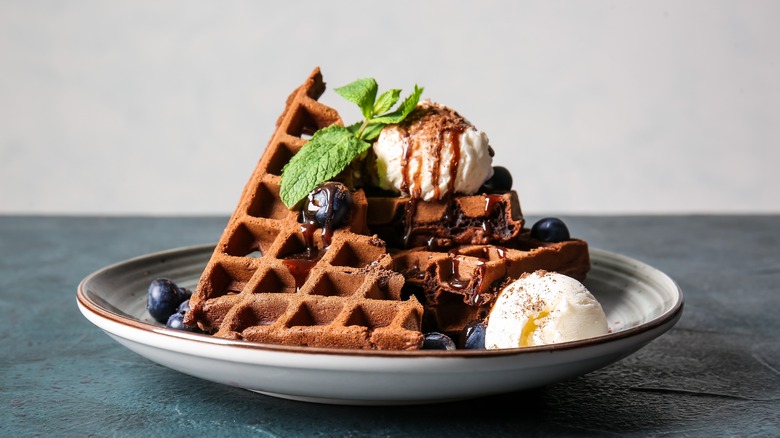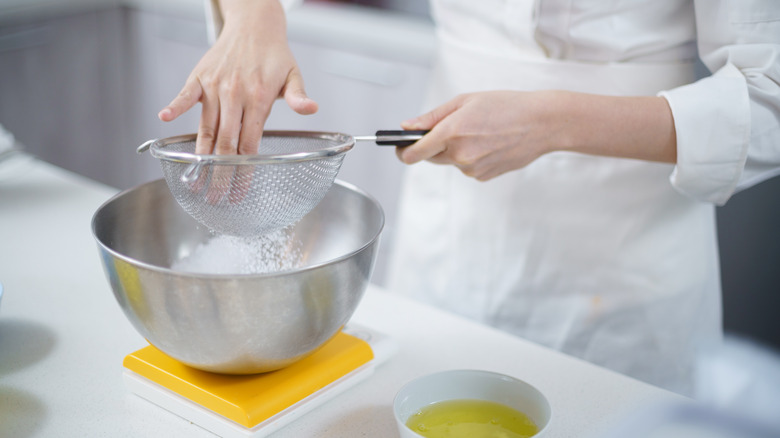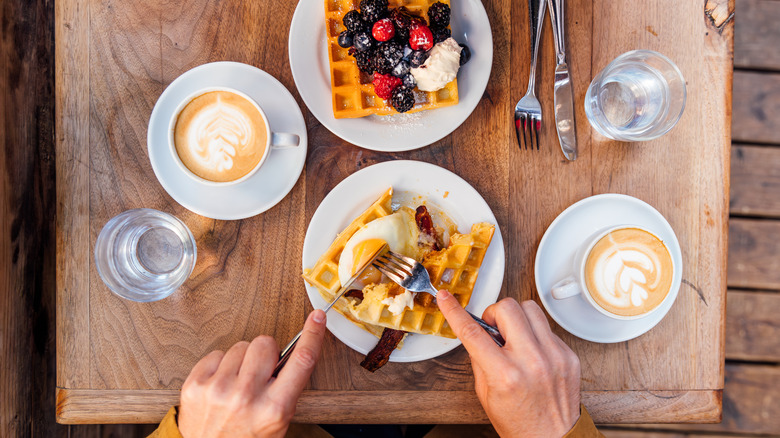Why Waffles Always Taste Better At A Restaurant
We may receive a commission on purchases made from links.
The dream restaurant waffles are perfectly crisp on the outside yet soft and fluffy on the inside. Their flavor is sweet with the warmth of vanilla coming through and a subtle complexity. So, why are the waffles you make at home often soggy or stodgy and overly sweet with little else going for them flavor-wise? It probably leaves you wondering how the pros do it.
Well, we've got the insight you've been dying for. We spoke to two trained pastry chefs who have ample experience with waffles. They told us the tricks of the trade and we're about to share them with you too. Never again will you end up disappointed by your homemade waffles once you learn the secrets of making them professional-quality.
Here's why waffles always taste better at a restaurant. You can take this information and learn to make your best-ever version. You'll know how to avoid those mistakes everyone makes with homemade waffles. Or, maybe you'll realize how much effort goes into making them perfect and just head to your favorite waffle spot instead.
Waffles at a restaurant may be yeast-risen
Here's a secret that you might not know. Your favorite restaurant waffles could be yeast-risen. This means that instead of baking powder or baking soda, they have yeast in the mixture to make them light and fluffy. It makes a difference to the flavor and the texture — and it could be why your homemade waffles just aren't the same as the ones you love from a particular restaurant or diner.
We spoke to Adriano Zumbo, a world renowned pastry chef who has also featured in several TV shows including "Zumbo's Just Desserts" and "Sugar Rush," to get his take on all things waffle-related. "I like to make waffles risen with yeast mainly, they are a lighter, more airy texture from the air bubbles caused by fermentation," says Zumbo. They also come out with a crispier outer crust," he adds.
But, not all chefs agree. Cynthia Christensen, an experienced pastry chef and recipe developer at But First We Brunch, thinks baking soda brings something extra to the party. She even uses it when making yeasted waffles. "Baking soda does more than help make light and fluffy waffles, it also helps with browning and crisps the outside as they cook," she says. So, you might want to experiment with both versions to see what works better for you and gives you the results you're looking for.
Chefs use higher-quality butter and eggs
Waffles use fairly simple ingredients. So much so that ingredient quality doesn't make as huge a difference as it does with some recipes. However, chefs know which ingredients are worth splurging on — and this is part of why restaurant-quality waffles are better.
Cynthia Christensen has a couple of favorite lower protein flours she likes to use, such as those from the White Lily and King Arthur brands. "I also use pasture raised eggs, which have a larger and fattier yolk," she tells us. "Both of those things together help me to get a lighter and better tasting waffle."
"The ingredients in a waffle batter are pretty basic staples so ingredient quality won't make a huge difference," explains Adriano Zumbo. However, he says that he splurges on high-quality butter, as this improves the flavor of the finished waffles.
If you're not sure which ingredients matter, it's worth experimenting. Once you find the ones you love, stick with them. "What I tell readers and home cooks is to find ingredients that work best for you and be monogamous with those ingredients," remarks Christensen. "If you want to have consistent results, use consistently good ingredients."
Restaurant waffles may contain quality vanilla extract -- but not all chefs use it
You may think that waffles from a restaurant always contain vanilla but it's not as simple as that. It depends on the flavor profile of the waffles and the preferences of the chef. And, of course, if the batter is going to be used for both sweet and savory versions, it won't contain vanilla extract.
"I'm going to say something controversial right now, but I don't always add vanilla extract to my waffles," says Cynthia Christensen. "By the time the waffles finish cooking and caramelizing on the outside, I don't think you really taste the vanilla," she explains.
However, if you're going to add vanilla, then quality matters. "I love adding good quality vanilla extract to my waffles," says Adriano Zumbo. "It brings a beautiful flavor and fragrance that enhances the batter and matches any toppings you pair with it." If you want to go all out in the vanilla, consider using vanilla bean paste. It's pricey, but it tastes so much more richly vanilla-ish than extract.
Chefs may use extra ingredients to flavor waffles
Restaurant waffles often taste better than homemade because chefs use extra ingredients to boost their flavor. While you might add a dash of vanilla extract at home, chefs may go beyond that. There are all kinds of ingredients to experiment with that make waffles incredible.
Adriano Zumbo suggests experimenting with other extracts that match the flavor of your toppings. Almond extract, for example, can give waffles a subtle nuttiness. Or, for a richer taste, you could mix in a hint of hazelnut extract, which pairs beautifully with whipped cream, chocolate, and berries.
Chocolate is another popular choice, with chefs adding cocoa powder or even melted chocolate to the batter for a deep, decadent flavor. Some restaurants add a splash of Guinness or other stouts, which gives waffles a slight malty taste that works well with syrup or chocolate sauce. For a lighter, brighter flavor, lemon zest is ideal, bringing tart notes to balance the sweetness.
During the fall, you might come across pumpkin waffles, with pumpkin purée and spices like cinnamon, nutmeg, and cloves added. Sourdough starter is another option — it adds a slight tang that makes waffles taste more complex and similar to those risen with yeast. Sourdough is great for savory waffles but it also brings some contrast to sweet dishes.
The batter is left to rest for restaurant-quality waffles
If you use your batter straight after you mix it up, this could be why your waffles don't live up to the expectations set by your restaurant faves. Chefs always leave batter to rest and for good reason. We get it — if you're eagerly waiting to eat waffles, putting the batter aside for 30 minutes doesn't seem all that appealing. And you might assume it doesn't make much difference anyway. However, it genuinely does improve the recipe.
According to Cynthia Christensen, you should rest your batter for at least 15 to 20 minutes before cooking it. "This allows time for the flour to hydrate completely, and gives you a nice thick batter that holds its shape when you portion it into your waffle maker," she says. "There's nothing worse than adding a loose waffle batter into your waffle maker and have it immediately leak and cook on the outside of your waffle maker," she adds.
Adriano Zumbo explains that resting time is especially important with certain types of waffle batters. "For yeasted waffles, yes, the batter needs to rest and the yeast goes to work and does its thing in creating bubbles and fermenting," he notes. He mentions that this also gives the flour time to absorb the liquids in the recipes and allows the starches to start to work.
Chefs pay attention to the temperature of the batter
The temperature of your waffle batter has probably never crossed your mind but it impacts the results of your waffles more than you might think. Chefs are more likely to be aware of this, hence the tastier offerings at restaurants, diners, and brunch spots.
When baking at home, Cynthia Christensen likes to have all of the ingredients in her waffle batter at room temperature. "That way when the batter hits the hot waffle maker, I'm not trying to overcome the chill of the batter at the same time as I'm trying to cook the inside," she explains. "Having a room temperature batter helps your waffles to cook more consistently from the inside out." However, she mentions that "in a restaurant setting you try to keep your waffle batter cold because it will be used throughout service, often for hours." This longer resting time for the batter can result in better flavor.
Adriano Zumbo agrees that roughly room temperature is best for waffle batter. However, the exact temperature depends on the type of batter. He notes that it's best at "the lower side of room temperature for yeasted, and room temperature for baking soda raised." A cooler temperature gives yeasted waffles more flavor due to the slow rising time, without letting them become overproofed.
Waffle makers in commercial kitchens perform better
Of course, talented chefs play a big role in why waffles from a restaurant are better than most homemade offerings. However, part of why you can't manage to achieve the same results is down to equipment. The waffle irons in professional kitchens are next level and perform better than home appliances.
"Waffle makers in commercial kitchens are usually of commercial grade," explains Adriano Zumbo. "They are a lot more powerful with thicker steel molds that hold the heat for a better cook and waffle crust," he adds. This makes a big difference to how waffles turn out.
"In a commercial kitchen I have used both the Wells WB-1 and a commercial Waring waffle maker and both put out amazingly consistent waffles," says Cynthia Christensen. However, she notes that she never thought that the brand of waffle maker would make a big difference at home.
She used a Black & Decker waffle iron in her own kitchen for years and made pretty good waffles. "Then I decided to splurge and purchased myself the same waffle maker that Ina Garten uses, an All Clad stainless steel Belgian waffle maker, and my waffle quality was markedly improved," Christensen tells us. "They had consistent browning over both the top and the bottom of the waffle without having to flip the waffle maker, they release the waffles easily, and they stay at a consistent heat all the time."
The crispiest restaurant waffles may be made using oil instead of batter
Restaurant waffles often have a perfect, crispy exterior that can be hard to recreate at home. One reason for this is that some chefs use oil instead of butter in their waffle batter. Oil has a lower water content than butter, so it doesn't create as much steam when cooking. Less steam means less moisture, which leads to a crisper waffle. Using oil also leads to a thinner batter with more evenly distributed fat — another factor in getting the crispy results you're after.
Not all chefs rely solely on oil, though. Some prefer the rich flavor that butter brings, even if it sacrifices a bit of crispiness. So, you might still be wondering whether to use oil or butter in waffles. For those who want the best of both worlds — crispness and a buttery taste — a blend of both oil and butter can work wonders.
If you're making waffles at home, try experimenting with different amounts of oil and butter in the batter. Start by swapping some of the butter for oil, or look for recipes that call for both ingredients. You might find that the right balance gives you waffles that are just as crispy as your restaurant favorites.
Chefs make sure to keep their waffle iron well oiled or buttered
Another way to get crispier waffles on the outside is to make sure you always grease your waffle iron before adding batter. You should do this for every waffle, not just for the first one while the machine's warming up. It makes more of a difference than you might think and is worth the extra few seconds it takes.
"My tip for restaurant style waffles [is] to keep your iron buttered or oiled to get a crisper outer cook," advises Adriano Zumbo. This is something that chefs do in restaurants and diners, and it might be the missing piece of advice to help you get the waffles of your dreams.
And, of course, buttering or oiling your waffle maker has another advantage beyond crispiness: preventing sticking. If you ever struggle with waffles getting stuck in the iron or tearing when you try to get them out, you probably aren't oiling the cooking surface well enough. Sure, many home waffle makers have a nonstick surface, but this can lose effectiveness over time.
The best waffle makers have a cast iron surface, as this retains heat brilliantly and is way more durable. However, in these cases, they need to develop a nonstick seasoning that can be hard to achieve when you aren't making a huge volume of waffles like a restaurant does. Zumbo notes that "your machine also isn't well seasoned with everyday use and flavor as a restaurant machine."
Restaurants have spent time developing proven recipes and ratios
It seems obvious, but one of the reasons why restaurant waffles taste better is simply that you aren't a professional chef. You might have a favorite waffle from a cookbook or perhaps you just search online for recipes every time you want to make this dish. Chefs have tried and tested recipes that they're improved and developed over years, so they can't be compared.
According to Adriano Zumbo, "restaurants that do it well will have proven systems and ratios of the waffle batter." They'll have recipes that they've perfected and know the ratio of each ingredient to use in the batter so they can easily scale it up or down depending on their needs without affecting the finished dish.
The other thing chefs have is experience and training. At eateries where waffles are sold, they might make hundreds a day. This gives them time and opportunity to perfect their technique. An average home cook might make waffles a few times a year — but even if you made them weekly, it's still not the same as whipping them up multiple times a day, every day.
Some chefs finish their waffles in the oven for crispier results
Sogginess is among the biggest problems people often face when making waffles at home. But, those served in restaurants are often perfectly crisp. How? Well, some chefs may finish their waffles in the oven to give them the crunchy exterior that people love so much.
"One thing you notice when making waffles is that your waffle maker will steam for a long time, and then when it stops steaming it will beep or light up that it's done," says Cynthia Christensen. "That steaming is from the release of the moisture from inside and outside of the waffle," she explains. However, she notes that there's often still surface moisture on them when the cooking time is up. This can ultimately lead to soggy results. "Giving your waffles [a] five minute rest in a 250 degree [Fahrenheit] oven will evaporate any remaining surface moisture and give you a crispier waffle experience," Christensen tells us.
The bonus to finishing waffles in the oven is that this is a great way to reheat them. It's great in restaurants where waffles might be made in advance and finished in the oven. But, it's also perfect when cooking for a crowd at home.
You may find stuffed waffles on restaurant menus
One difference you might notice between homemade and restaurant waffles is that restaurant versions are more elaborate. Stuffed waffles are commonly found on menus. These have fillings between two layers of batter. As the waffle cooks, the filling warms up and blends with the waffle. You get more variation in taste and texture from a stuffed waffle.
It's totally possible to make them at home, though. You can stuff waffles with just about anything. For a sweet breakfast or dessert, fillings like chocolate or berries are delicious. If you're in the mood for something savory, go for fillings like scrambled eggs or cheese. The savory options make a great choice for brunch or a quick lunch — or any time you're trying to avoid a major sugar rush.
You can make them with a regular waffle maker — you don't need any fancy equipment. Just pour a little batter, add your filling, and cover it with more batter. Close the waffle maker and cook as usual. It seems way trickier and more impressive than it really is, giving you restaurant-quality waffles with not much extra time or effort.
Chefs put a lot of effort into their toppings
Yes, the quality of the waffles themselves is important but toppings can also make or break them. Great waffles can be ruined by subpar toppings and just-okay waffles can be elevated by great ones. Chefs often put a lot of effort into their toppings and this shows.
Adriano Zumbo points out that chefs use "good quality toppings" including syrups, creams, fruits, ice cream, and a range of savory toppings. "The waffle toppings are where you need to use quality — they are where the flavor is going to shine," he says. He also talks about the importance of getting the right ratio of waffles to toppings, so you get an even balance of ingredients.
There are various types of waffles with a range of toppings that go beyond the everyday. You might want to try toppings like smashed avocado, tomato and mozzarella, sausage gravy, strawberries and cream, or peanut butter and chocolate. Elevating waffle toppings is also sometimes about going with the unexpected or using fancier versions of classic combinations. For instance, instead of using Nutella, you could make your own chocolate-hazelnut spread and drizzle it on your waffles before topping them with poached pears.













